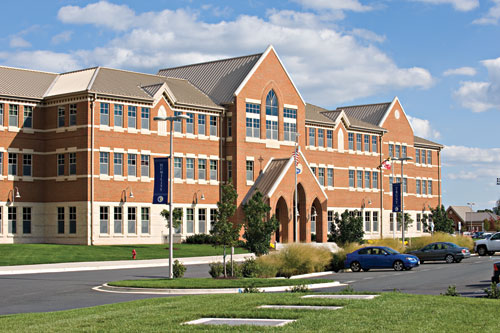First in Their Class: Innovative Design Solutions for Schools of the Future
Cool Roofs with Cool Colors and Building Integrated PV Panels
One of the simple strategies for reducing the solar gain on a roof system includes the installation of a cool roof. Cool roofs reflect solar visible, ultraviolet and infrared rays as well as have a property of high thermal emittance-the ability to radiate absorbed, non-reflected solar energy. The U.S. Environmental Protection Agency (EPA) estimates that Americans spend about $40 billion annually to air-condition buildings.9 An innovation to this energy saving strategy is the removal of one of the obstacles for the application of cool roof specifications. Designers have resisted choosing cool roofs because of the limited roof color palette that met a design professional's aesthetics or project budget.
Cool roofs that are ENERGY STAR-qualified reflect more of the sun's rays and are estimated to lower the roof surface temperature by up to 100 °F, decreasing the amount of heat transferred into buildings and lowering the cost of air-conditioning. According to ENERGY STAR, qualified roof products can help reduce peak cooling demand by 10 to 15 percent.10 The ENERGY STAR cool roof project includes research by The Oak Ridge National Laboratory, as well as partnerships with roofing manufacturers who agree to continue testing for certification of their products.
ENERGY STAR metal roofs must meet tests that include the ASTM C1371 - 04a Standard Test Method for Determination of Emittance of Materials Near Room Temperature Using Portable Emissometers and ASTM C1549 - 09 Standard Test Method for Determination of Solar Reflectance Near Ambient Temperature Using a Portable Solar Reflectometer. Variegated roof products may also be rated according to the Cool Roof Rating Council (CRRC) Test Method #1.
Metal ENERGY STAR cool roofs have performance requirements based on the slope of the roof. Solar reflectance is a measurement from 0 (no reflectance) to 100 (highly reflectant). The initial Solar Reflectance Index (SRI) of a low-slope roof (less than a 2:12 pitch) is greater than or equal to 0.65 and after three years, greater than or equal to 0.50. The initial SRI of a steep roof must be greater than or equal to 0.25 or greater than or equal to 0.15 after three years. Partners in the ENERGY STAR program must offer warranties equal to those of their products that may not have these characteristics. Emissivity is a measurement between 0 percent and 1 (100 percent). An ongoing discussion among professionals and scientists is whether a highly emissive roof is better in cold cloudy climates. ENERGY STAR does not require minimum emissivity values for roofing products.
Up to recently, most cool roofs were white or a light color compromising many designs that required darker or broader color palettes. New infrared-reflective pigments have been developed for metal roofs that allow even dark colors, to achieve higher reflectivity values. Architects can choose from broad color palettes of ENERGY STAR colors to meet the requirements set forth by rating systems to reduce the heat island effect. Dark bronze, greens, colonial reds, browns, deep charcoal roofs are among a variety of color choices provided to the designer with high solar reflectance values.
New cool metal roofs also offer a platform for the integration of solar power. Building integrated photovoltaics (BIPV) are innovative thin-film laminates that can be applied directly to metal roofing panels. This factory-installed system is part of the roof finish; they require no penetrations through the roofing at the construction site. The metal standing seam roof locks together in panels that are attached to the roof by channels.
 |
Standing seam metal roofs bring new aesthetics to school designs. Photo courtesy of Petersen Aluminum Corporation |









